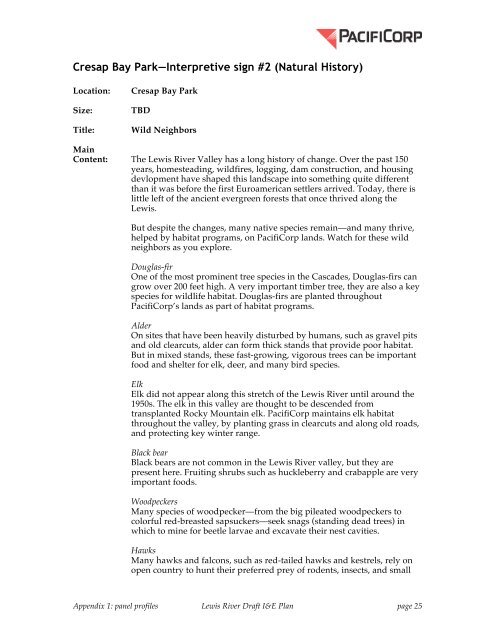The Lewis River Hydroelectric Projects - PacifiCorp
The Lewis River Hydroelectric Projects - PacifiCorp
The Lewis River Hydroelectric Projects - PacifiCorp
You also want an ePaper? Increase the reach of your titles
YUMPU automatically turns print PDFs into web optimized ePapers that Google loves.
Cresap Bay Park—Interpretive sign #2 (Natural History)<br />
Location:<br />
Size:<br />
Title:<br />
Cresap Bay Park<br />
TBD<br />
Wild Neighbors<br />
Main<br />
Content: <strong>The</strong> <strong>Lewis</strong> <strong>River</strong> Valley has a long history of change. Over the past 150<br />
years, homesteading, wildfires, logging, dam construction, and housing<br />
devlopment have shaped this landscape into something quite different<br />
than it was before the first Euroamerican settlers arrived. Today, there is<br />
little left of the ancient evergreen forests that once thrived along the<br />
<strong>Lewis</strong>.<br />
But despite the changes, many native species remain—and many thrive,<br />
helped by habitat programs, on <strong>PacifiCorp</strong> lands. Watch for these wild<br />
neighbors as you explore.<br />
Douglas-fir<br />
One of the most prominent tree species in the Cascades, Douglas-firs can<br />
grow over 200 feet high. A very important timber tree, they are also a key<br />
species for wildlife habitat. Douglas-firs are planted throughout<br />
<strong>PacifiCorp</strong>’s lands as part of habitat programs.<br />
Alder<br />
On sites that have been heavily disturbed by humans, such as gravel pits<br />
and old clearcuts, alder can form thick stands that provide poor habitat.<br />
But in mixed stands, these fast-growing, vigorous trees can be important<br />
food and shelter for elk, deer, and many bird species.<br />
Elk<br />
Elk did not appear along this stretch of the <strong>Lewis</strong> <strong>River</strong> until around the<br />
1950s. <strong>The</strong> elk in this valley are thought to be descended from<br />
transplanted Rocky Mountain elk. <strong>PacifiCorp</strong> maintains elk habitat<br />
throughout the valley, by planting grass in clearcuts and along old roads,<br />
and protecting key winter range.<br />
Black bear<br />
Black bears are not common in the <strong>Lewis</strong> <strong>River</strong> valley, but they are<br />
present here. Fruiting shrubs such as huckleberry and crabapple are very<br />
important foods.<br />
Woodpeckers<br />
Many species of woodpecker—from the big pileated woodpeckers to<br />
colorful red-breasted sapsuckers—seek snags (standing dead trees) in<br />
which to mine for beetle larvae and excavate their nest cavities.<br />
Hawks<br />
Many hawks and falcons, such as red-tailed hawks and kestrels, rely on<br />
open country to hunt their preferred prey of rodents, insects, and small<br />
Appendix 1: panel profiles <strong>Lewis</strong> <strong>River</strong> Draft I&E Plan page 25
















